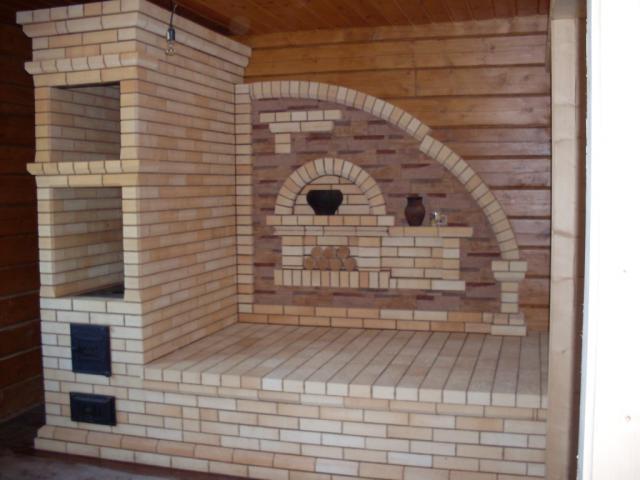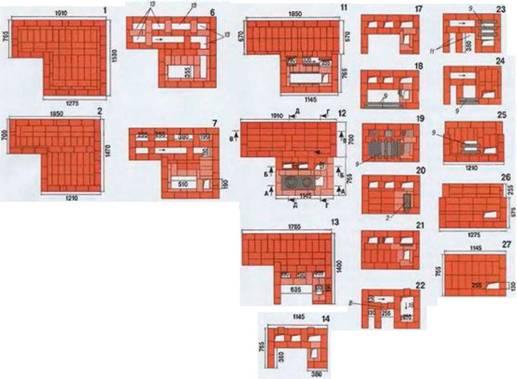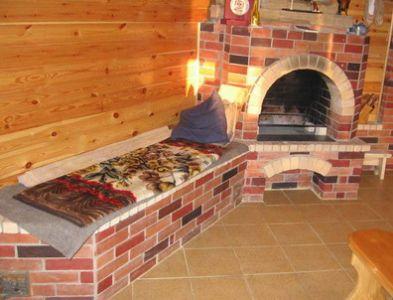Cozy and comfortable
Since ancient times, people have used stoves to heat their homes and cook food. Over time, their design gradually changed, but the purpose remained the same. Very effective and practical at the present time is a heating stove with a stove bench called "Swede". It was first developed by the designer G. Reznik and presented in 2010 in the Dom magazine.
Advantages and disadvantages of the furnace
This design has a lot of positive aspects:
- Small size, which makes it possible to install it in a small house.
- The power of the device allows you to heat an area up to 35 m 2. Has "summer" and "winter" modes.
- To increase the reliability of the furnace, the firebox and channels are lined with refractory bricks.
- The Swede oven is designed for location in the wall between the kitchen and the room. Thus, there is a rapid heating of the kitchen and dining room, and the living room gradually warms up.
- The materials and equipment for mounting the product are quite simple and inexpensive.
- It is possible to attach a cozy and comfortable stove bench to the stove.
- The whole design of the stove can be made decorative, and it will perfectly fit into the interior of the house.
With a lot of advantages, the furnace also has some disadvantages:
- The firebox of the product is made in the width of the furnace, and this is very inconvenient in terms of stacking firewood in such a long space.
- It takes a lot of time for installation and drying of brickwork.
Device and principle of operation
The Swede has a large oven, which does not reach the flame. It is intended not only for baking, since the furnace part in the furnace is necessary for chemical afterburning of fuel. A metal oven quickly heats up when the first heat appears. After kindling, when you open its door after 3 minutes, you can hear how warm air comes from it, because the stove starts to heat from the floor, and not from above. Flue gases go from top to bottom from the furnace to heat the oven.
The heating device has an upper niche of a sufficiently large size - two people can put winter clothes here. Niche heating comes from the first heat and the second. The Swede also provides a niche above the stove. It is covered with a wooden lid. And due to this, the food left in the oven remains warm for a long time.
The designers did not make an outlet between the smoke circulation and the furnace, as this complicates the product, and its price increases. They got out of the situation by making an overflow at the bottom under the oven.
When using such a device, if you do not close the view, the stove will cool down quickly. Therefore, it is necessary to monitor the condition of the fuel in the furnace in order to close the view in time, preventing carbon monoxide from entering the room, which can lead to sad results.

Tasteful design
The heating of the entire furnace is carried out according to the well-known channel scheme. That is, heating is carried out by the second heat and the heat of embers. When using vertical channels, heating from below is worse, but soot accumulates less. And this is quite important when using different fuels. It is also possible to use horizontal channels. In this case, the oven heats better from below, but it is necessary to clean it often.
In the product, the channel smoke circulation is made simple, so the order of the furnace can be changed depending on the requirements, and at the same time the quality of the product does not deteriorate. The heating and cooking stove in the 3rd row lies as the order indicates. The back of the stove goes into the living room, where you can attach a stove bench. It turns out to be quite large - 180 × 66 cm, and a tall person will be completely accommodated on it.
The development of the Swede is a very good solution. It has an efficiency slightly less than in a Russian stove, but exceeds the heat transfer of a Dutch stove. From the material that needs to be spent on the construction of a Dutch woman with a capacity of 2500 Kcal / hour, you can build a Swede, whose capacity will be 3500 Kcal / hour, and at the same time it is necessary to heat it 2 times a day. The Swedish oven is very convenient to cook food. You don't have to bend over, and you don't need a grip.
To make a Swede, it is necessary to use high quality material and do the work carefully, observing the order, all sizes and rules during construction.
The subtleties of building a stove
The quality of heating is determined by the proportions of the fuel part. All its dimensions must strictly comply with the drawings, otherwise there will be violations when using the device. The designers approved the following dimensions:
- Plate - 710 × 410 mm.
- Furnace compartment - 330x356x506 mm.
- Oven - 305x381x506 mm.
- The thickness of the metal walls of the oven is within 4–6 mm. This size is of great importance, since when it is reduced, the walls will quickly burn through. And thick walls will quickly remove heat, and their warm-up time will increase. These moments will lead to fuel underburning and soot deposition, and at the same time efficiency will drop. These points also apply to the plate, so cast iron or special steel is the best option for it.

Design planning
If you want to build such an efficient stove with your own hands, then you must follow the recommended proportions. The oven is heated from all sides by hot gases. Therefore, from its back to the wall of the furnace, it is necessary to make a gap of one and a half bricks. You can make a firebox close to the oven by isolating the near wall from the fire with asbestos.
An important element of the furnace device is the door. It is also his weak point. If it is made of thin low-quality material, then it is loosened from thermal loads and may fall out. It is advisable to immediately insert a cast iron door with a mustache immured in the masonry. If there is no mustache in the purchased door, do not be discouraged - you can make them yourself by welding 60 mm long wire to the corners of the door. And do not forget to part it in the form of the letter V, and also wall it up. To keep the finished door with a mustache for a long time, it must be reinforced with a steel strip or corner.
Building a Swede is not so easy. When heated, all the heat goes towards the floor, so it is necessary to make it well insulated. At the present time, there are quite a lot of high quality materials. We will use one of them - this is basalt cardboard. It is laid in three layers. It turns out insulation of 15 mm. A foil sheet is also laid in the middle and top layer.
The foot of the furnace is laid with wide seams - 6–13 mm. Due to this, a protrusion in the form of a pedestal is obtained. All bricks must be soaked in water before laying. This removes dust and increases their adhesion. This is necessary because the stove has a large thermal stress, and the use of dry and dusty material will lead to fragility of the structure. The masonry mortar must also be of excellent quality on marl clay.
When building a firebox, it is necessary to use yellow brick. It is a fireclay building material that can withstand very high temperatures. The solution is also used using fireclay clay. The smallest joint width between fireclay and ordinary masonry is 6 mm. Only the firebox is laid out of fireclay, although ideally it would be necessary to lay out the entire furnace. But this is an expensive material, so they save it.

Comfort in a wooden house
When laying out the design of the Swedish oven, it is necessary to cut the bricks evenly to the desired size. This can be done with a grinder. You can see in the drawing that some of the corners are rounded. This must be done, as the corners will weaken the draft due to the resulting flue gas swirls.
It is generally undesirable to use metal in a furnace. But in Swede, they decided to use it initially to reduce the cost of the product. A layer of mortar of 6 mm is applied to metal parts from all sides.
Furnace start
It is strictly forbidden to put a wet structure into operation. The oven needs to be completely dry. This lasts approximately 4 weeks. Two weeks of "cold drying" and the rest of the time "warm". During the “warm” drying, crumpled dry newspapers are placed in the cleaning doors. An indicator of a dried oven is the cessation of paper dampening.
It is also necessary to carry out "hot" drying, in which the furnace is heated with a gradual increase in the amount of furnace material.
Conclusion
Building a stove with a stove bench with your own hands is not as difficult as it might seem at first glance. Moreover, such a design is necessary for a dwelling of a small area where people live all year round. After all, with irregular heating, the device becomes damp, and it requires a long drying time. If you constantly heat the stove, then in terms of quality and size it becomes a good heating and cooking household appliance, economical and convenient.